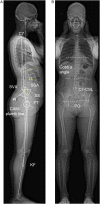Spinopelvic Alignment as a Risk Factor for Poor Balance Function in Low Back Pain Patients
- PMID: 35220778
- PMCID: PMC10538310
- DOI: 10.1177/21925682221076417
Spinopelvic Alignment as a Risk Factor for Poor Balance Function in Low Back Pain Patients
Abstract
Study design: Retrospective, observational study.
Objectives: This study aimed to examine the association between spinopelvic parameters and balance function in low back pain (LBP).
Methods: Among patients in the rehabilitation medicine department, the data of 182 patients (mean age, 47.8 years; M/F = 64/118) was obtained retrospectively. Spinopelvic parameters were measured through a whole-body low-dose biplanar radiography using the EOS imaging system, and balance function was evaluated by the center of pressure (COP) movement using the Zebris treadmill system. Pearson correlations were used to determine the relationship between radiographic and balance function. Stepwise multiple linear regression analyses were conducted with the balance function as a dependent variable and age and spinopelvic parameters as independent variables.
Results: Increased age, knee flexion (KF), pelvic tilt (PT), C7-central sacral line (C7-CSL) and C7 sagittal vertical axis (SVA), and decreased spino-sacral angle (SSA) were associated with both poor static and dynamic balance. Moreover, increased Cobb's angle and decreased thoracic kyphosis (TK) and lumbar lordosis (LL) was associated with poor static balance. Increased pelvic incidence (PI) was related to poor dynamic balance. Increased age, Cobb's angle, SVA, and decreased TK were risk factors for poor static balance. For dynamic balance, increased age, C7-CSL, and PT were risk factors for poor sagittal balance, whereas increased CAM-plumb line and PT were risk factors for poor coronal balance.
Conclusions: Balance function was associated with spinopelvic parameters in patients with LBP. Increased SVA, followed by increased PT, was the strongest independent factor associated with poor static and dynamic balance.
Keywords: low back pain; pelvis; postural balance; spine.
Conflict of interest statement
The author(s) declared no potential conflicts of interest with respect to the research, authorship, and/or publication of this article.
Figures


Similar articles
-
Effect of Coronal and Sagittal Spinal Malalignment on Spinopelvic Mobility in Patients Undergoing Total Hip Replacement: A Prospective Observational Study.Clin Spine Surg. 2022 Jul 1;35(6):E510-E519. doi: 10.1097/BSD.0000000000001300. Epub 2022 Mar 3. Clin Spine Surg. 2022. PMID: 35239531
-
Spinopelvic sagittal imbalance as a risk factor for adjacent-segment disease after single-segment posterior lumbar interbody fusion.J Neurosurg Spine. 2017 Apr;26(4):435-440. doi: 10.3171/2016.9.SPINE16232. Epub 2017 Jan 6. J Neurosurg Spine. 2017. PMID: 28059683
-
The use of the T1 sagittal angle in predicting overall sagittal balance of the spine.Spine J. 2010 Nov;10(11):994-8. doi: 10.1016/j.spinee.2010.08.031. Spine J. 2010. PMID: 20970739
-
Does Total Hip Arthroplasty Affect Spinopelvic and Spinal Alignment?: A Prospective Observational Investigation.Clin Spine Surg. 2022 Oct 1;35(8):E627-E635. doi: 10.1097/BSD.0000000000001320. Epub 2022 Mar 30. Clin Spine Surg. 2022. PMID: 35351837
-
Spinopelvic Compensatory Mechanisms for Reduced Hip Motion (ROM) in the Setting of Hip Osteoarthritis.Spine Deform. 2019 Nov;7(6):923-928. doi: 10.1016/j.jspd.2019.03.007. Spine Deform. 2019. PMID: 31732003 Review.
Cited by
-
Impact of the hip osteoarthritis on sagittal spine-pelvis alignment parameters in lumbar spinal stenosis with sagittal malalignment: a propensity score matching study.Eur Spine J. 2024 Dec;33(12):4467-4475. doi: 10.1007/s00586-024-08536-8. Epub 2024 Oct 29. Eur Spine J. 2024. PMID: 39470750
-
Functional analysis of postural spinal and pelvic parameters using static and dynamic spinometry.Heliyon. 2024 Apr 4;10(7):e29239. doi: 10.1016/j.heliyon.2024.e29239. eCollection 2024 Apr 15. Heliyon. 2024. PMID: 38633646 Free PMC article.
-
Coronal and sagittal spinopelvic alignment in the patients with unilateral developmental dysplasia of the hip: a prospective study.Eur J Med Res. 2022 Aug 27;27(1):160. doi: 10.1186/s40001-022-00786-w. Eur J Med Res. 2022. PMID: 36030216 Free PMC article.
References
-
- Pollock AS, Durward BR, Rowe PJ, Paul JP. What is balance? Clin Rehabil. 2000;14(4):402-406. - PubMed
-
- Berg KO, Maki BE, Williams JI, Holliday PJ, Wood-Dauphinee SL. Clinical and laboratory measures of postural balance in an elderly population. Archives of physical medicine and rehabilitation. 1992;73(11):1073-1080. - PubMed
-
- Haas BM, Burden AM. Validity of weight distribution and sway measurements of the Balance Performance Monitor. Physiother Res Int. 2000;5(1):19-32. - PubMed
LinkOut - more resources
Full Text Sources
Research Materials
Miscellaneous


